Barry, Vale of Glamorgan, Wales, UK 作者: 来源: 发布时间:2021-09-18
I. Population and Area
Continent: Europe
Country: The U.K
State/Province: Wales
City/Town: Barry, Vale of Glamorgan
Total Area: 7.201 (sq mi)
Population in 2018: 51.52 (thousand)
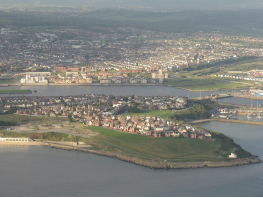
II. Natural Geography (environment and resources)
Barry Island
The Barry Island peninsula was an island until the 1880s when it was linked to the mainland as the town of Barry expanded. This was partly due to the opening of Barry Dock by the Barry Railway Company. Established by David Davies, the docks now link up the gap which used to form Barry Island. There is a railway station to access the island at Barry Docks, there is also a heritage railway station which houses refurbished steam passenger trains. The railway is open to the public and holds events involving a large steam engine replica of Thomas the Tank Engine. Barry Island is now known for its beach and Barry Island Pleasure Park. From 1966, the island was home to a Butlins Holiday camp, which was closed in 1987 and taken over by Majestic Holidays who renamed it Barry Island Resort. Between Butlins' closure and Majestic's reopening the camp was used as for filming scenes in the "Shangri-La" holiday camp from the Doctor Who serial Delta and the Bannermen. The camp closed in 1996 after Majestic had a disagreement with the local council, who refused an entertainments licence unless work was carried out to improve the now 30-year-old site. It was redeveloped for housing between 1997–2003 with the remaining two camp buildings and outdoor pool demolished in early 2005.
The preserved Vale of Glamorgan Railway runs on Barry Island. The BBC sitcom Gavin & Stacey was filmed in many areas of Barry and Barry Island. Long-running medical drama Casualty which is filmed in Cardiff, regularly films scenes in and around Barry Island.
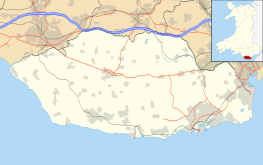
Climate
As with the rest of the British Isles and Wales, Barry experiences a maritime climate with cool summers and mild winters, and often high winds. It is amongst the sunnier of Welsh locations, due to its southerly and coastal position. The nearest official weather observation station is at Cardiff Airport near Rhoose, about 3 miles (5 km) west of the town centre.
Transport
The main forms of public transport in the town are bus and rail. Barry is served by Cardiff Bus which operates services to Llantwit Major, Penarth, Cardiff International Airport and Cardiff City Centre as well as operating town circular services. Barry's King's Square bus station is located on King's Square in the town centre. The A4050 road connects Barry to Culverhouse Cross Interchange and the rest of west Cardiff.
There are four railway stations in the town: Barry, Barry Docks, Barry Island and Cadoxton. These are operated and served by Transport for Wales and are on the Valley Lines network, a commuter rail network focused on Cardiff. Services operate westbound to Bridgend via Llantwit Major and Rhoose Cardiff International Airport, and eastbound to Cardiff Queen Street via Dinas Powys, Cardiff Grangetown and Cardiff Central. The latter service can continue to either Merthyr Tydfil, Pontypridd and/or Aberdare. Barry is located less than 3 miles (4 kilometres) east of Cardiff International Airport.
III. Economy
Average Hourly Rate in Barry, Wales: Vale of Glamorgan
£8.82


About Barry, Wales: Vale of Glamorgan
The average salary in Barry, Wales: Vale of Glamorgan is £8.82. Trends in wages decreased by -100.0 percent in Q3 2020. The cost of living in Barry, Wales: Vale of Glamorgan is 100 percent higher than the national average. The most popular occupations in Barry, Wales: Vale of Glamorgan are Care Worker, Joiner, and Carpenter which pay between £7.31 and £11.74 per year.
Regions (NUTS3) | GDP € (2013) | GDP per capita € (2013) | GDP € (2016) | GDP per capita € (2016) |
Gwent Valleys | € 5.962 bn | €17,500 | € 6.923 bn | €20,200 |
Bridgend & Neath Port Talbot | € 6.016 bn | €21,500 | € 7.240 bn | €25,400 |
Swansea | € 5.532 bn | €23,100 | € 6.332 bn | €25,800 |
Monmouthshire & Newport | € 6.322 bn | €26,500 | € 7.260 bn | €30,000 |
Cardiff & Vale of Glamorgan | € 14.361 bn | €30,000 | € 16.590 bn | €33,900 |
Flintshire & Wrexham | € 8.346 bn | €28,800 | € 9.374 bn | €32,200 |
Powys | € 2.869 bn | €21,600 | € 3.134 bn | €23,700 |
TOTAL | € 71.396 bn | €23,200 | €81.683 bn | €26,200 |
Reference Website:
https://www.payscale.com/research/UK/Location=Barry-Wales%3A-Vale-of-Glamorgan/Salary
IV. Industrial Characterisitics
Major industries:
By 1871 the population of Barry was over 100, with 21 buildings, the new estate-owning Romilly family being involved in the buildup of the village but it remained a largely agricultural community. It grew when it was developed as a coal port in the 1880s. The coal trade was growing faster than the facilities at Tiger Bay in Cardiff ever could and so a group of colliery owners formed the Barry Railway Company and chose to build the docks at Barry. Work commenced in 1884 and the first dock basin was opened in 1889 to be followed by two other docks and extensive port installations. The Barry Railway brought coal down from the South Wales Valleys to the new docks whose trade grew from one million tons in the first year, to over nine million tons by 1903. The port was crowded with ships and had flourishing ship repair yards, cold stores, flour mills and an ice factory. By 1913, Barry was the largest coal exporting port in the world.
Behind the docks rose the terraced houses of Barry which, with Cadoxton, soon formed a sizeable town. The railways which had played a major part in the development of the dock helped make Barry Island a popular resort. Barry Memorial Hall on Gladstone Road was inaugurated in November 1932, and obtained its name to honour those locals who lost their lives in World War I. During its industrial peak a number of ships sank off the Barry coast.
Major projects and related introductions:
Major Vale of Glamorgan regeneration project approaching significant milestone
The former railway storage building on Hood Road in Barry is being converted into a shipping container village of office space, retail units, restaurants and a coffee shop alongside an apartment complex. And the first component of the scheme is nearing completion, with some businesses due to be operating from their new premises in a matter of weeks. Loftco, the company behind the scheme, has begun revealing which businesses will occupy space at the development.
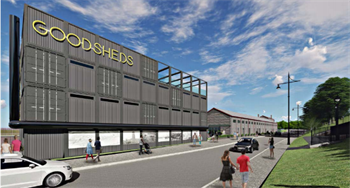
They include Spectrum Collections, an international make up brand founded in Barry with a growing reputation in Hollywood and fitness firm Brawd Men’s Health.
The project also includes a permanent farmers market, cinema screen, outdoor gym, theatre and comedy club, which can all be used by the local community. t is the latest example of large-scale regeneration work taking place in the Vale and is located within Barry Waterfront’s Innovation Quarter.
That area already houses the award-winning Hang Fire Southern Kitchen, Academy espresso bar and other businesses, operating as part of the Pumphouse redevelopment. ike the Goods Shed, that was a 19th Century building with strong historical significance that has been brought back into use.
Reference Website:
https://www.valeofglamorgan.gov.uk/en/our_council/press_and_communications/latest_news/2020/May/Major-Vale-of-Glamorgan-regeneration-project-approaching-significant-milestone.aspx
V. Attractions
1. Whitmore Bay:
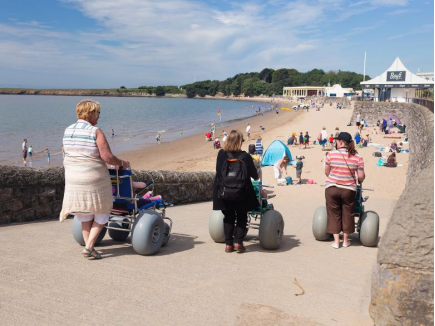
Come and seek out the all-year round resort of Barry Island for all the fun of the seaside. You may have already seen it on BBC's award winning TV series Gavin & Stacey, which is set in Barry and Essex.
Whitmore Bay is a brilliant beach - perfect for families and dog walkers (seasonal restrictions apply). Imagine a huge crescent of golden sand and plenty of space to set up your sun umbrella. You can hire one of the colourful, iconic Barry Island beach huts for the day or explore the dazzling lights of the nearby Barry Island Pleasure Park. To top it off, the recently refurbished promenade is full of thriving cafés, traditional fish and chip shops, amusement arcades and all the things you need for a great day out at the beach. The beach is also accessible to those less able with the free loan of beach wheelchairs from the Vale of Glamorgan Council.
2. BARRY WAR MUSEUM:
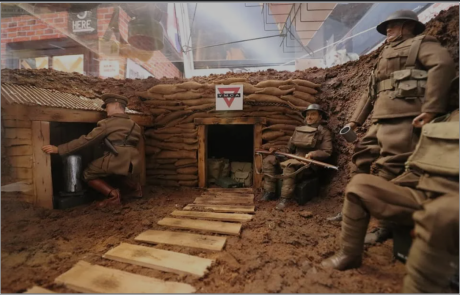
The Barry War Museum (run by the Barry at War Group) aims to research, preserve and promote the wartime history of the town and surrounding area. Their aim is to support schools and groups researching the local war history of Barry and surrounding area, by exhibiting at heritage events and holding exhibitions about the topic, with the aim of educating the public. They also seek to learn more about this fascinating subject from those who lived through the area's wartime history.
3. Old Hall Gardens:
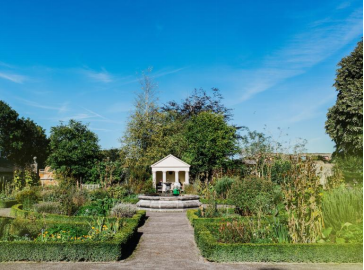
The market town of Cowbridge is an absolute delight with historic town walls, a blue plaque trail to follow and lots of fashionable independent shops. The Physic Garden and Old Hall Gardens are a must to sit, relax and take a breather. There's a superb range of eateries to finish off your Cowbridge experience.
Ancient buildings are everywhere in Llantwit Major, one of the Vale of Glamorgan’s most beautiful villages – the first church was recorded in the settlement more than 1,500 years ago. Lush countryside, caves and beaches make for glorious surroundings. St Donat’s Castle houses an Arts Centre with a year-round programme.
Reference Website:
https://www.visitwales.com/destinations/south-wales/visit-vale-glamorgan-gardens-parks-beaches-and-more
VI. History
Early history
The area now occupied by Barry has seen human activity in many periods of history. Mesolithic or Middle Stone Age microlith flint tools have been found at Friars Point on Barry Island and near Wenvoe and Neolithic or New Stone Age polished stone axe-heads were discovered in St. Andrews Major. A cinerary urn (pottery urn buried with cremation ashes) was found on Barry Island during excavations of Bronze Age barrows and two more were found in a barrow at Cold Knap Point. A large defended enclosure or Iron Age promontory hillfort was located at the Bulwarks at Porthkerry and there was evidence of the existence of an early Iron Age farmstead during construction of Barry College off Colcot Road.
In Roman times farmsteads existed on the site of Barry Castle and Biglis and there were verbal reports of discovery of a cemetery including lead coffins with scallop-shell decoration. Both St. Baruc's Chapel and St. Nicholas Church have re-used Roman bricks and tiles incorporated in their building fabric and a Roman villa was discovered in Llandough. In 1980 a Roman building consisting of 22 rooms and cellars in four ranges around a central courtyard was excavated at Glan-y-môr and is believed to be a third-century building associated with naval activity, maybe a supply depot.
Medieval Barry
The main feature of the area at this time was the island in the Bristol Channel, separated from the mainland by a tidal estuary. It is described in Giraldus Cambrensis or Gerald of Wales' Itinerarium Cambriae ("Journey through Wales", 1191). He states that Barry derives its name from St. Baruc whose remains are deposited in a chapel on the island. The local noble family who owned the island and the adjoining estates took the name of de Barri from the island.
Following the Norman conquest of England the area was divided into manors with the Barry area split into two large lordships, Penmark and Dinas Powys. Penmark was split into the sub-manors of Fonmon, West Penmark and Barry. Dinas Powys was split into the sub-manors of Cadoxton and Uchelolau ('Highlight'). The sub-manor of Barry was granted by the de Umfraville family to the de Barri family and the seat of the manor was Barry Castle, located on high ground overlooking the Bristol Channel, a site occupied in Roman times by a native homestead. The castle was a small fortified manor house, built to replace an earlier earthwork. By the late 13th century the castle had two stone buildings on the east and west sides of a courtyard. Early in the 14th century the castle was strengthened by the addition of a large hall and gatehouse on its south side, the ruins of which are all that survive today. By now Barry had grown into a village and port with its own church and watermill but in the 14th century its population was drastically reduced by the Black Death and the consequences of the rebellion of Owain Glyndŵr. It took the population some 300 years to recover and once more hold the title of village, essentially a sparsely populated area with a few scattered farms and much of the land a marsh that a small river flowed through. By 1622 the pattern of fields, where enclosure was almost complete, around Barry village was pretty much as it was to remain until the growth of the modern town. According to the 1673 hearth tax list the parish contained thirteen houses. Whitehouse Cottage, the oldest existing inhabited house in modern Barry, dates from the late 1500s with the east end of the building added in around 1600. It overlooks the sea at Cold Knap.
Barry Scrapyard
Following the rise of diesel and electric power on the UK railways, the marshalling yards at Barry Docks became the largest repository of steam engines awaiting scrapping in the UK. Dai Woodham owned the Woodham Brothers Scrap yard and he allowed rail preservation organisations to buy back the locomotives at the scrap value, allowing around 200 of the 300 locomotives to be saved for future generations, although during the years of storage many were vandalised or looted by souvenir hunters. When interviewed just before his death, Woodham was reluctant to take full credit for this and pointed out that the town of Barry with its redundant sidings was the major factor in allowing these locomotives to be saved.
VII. Culture
·Series 3–5 of "Being Human" (2010 on) was filmed in and around Barry Island, with much of the storyline referring to the town as "infested" with werewolves and vampires.
·The 2011 film Submarine, although set in Swansea was mostly filmed in Barry.
·Barry hosted the National Eisteddfod of Wales in 1920 and 1968.
·The Doctor Who serial Delta and the Bannermen was set and filmed in Barry.
·Several scenes of the Doctor Who episodes "The Empty Child" and "The Doctor Dances" were filmed at the Vale of Glamorgan Railway sites at Plymouth Road and Barry Island in January 2005.
·Gavin & Stacey is partly set and filmed in and around Barry.
·Art Central, a modern art gallery run by the local council, was created in the Town Hall as part of the library redevelopment in 2006.
·There is a Community Arts Centre being developed Named 'Canolfan Porthceri Centre', this is being developed within the building and grounds of Porthkerry Road Methodist Church, due to the Methodist Church Moving to new premises within the Waterfront Development.
·Watercolour artist Thomas Frederick Worrall lived in Barry from 1913 until his death in 1957. Several of his paintings of Barry and other areas in the Vale of Glamorgan are in the National Library of Wales.
·Composer Grace Williams (1906 – 1977), generally regarded as Wales's most notable female composer, was born in Barry and lived there during her latter years. Her best known works include Fantasia on Welsh Nursery Tunes and Sea Sketches.
·Memo Arts Centre on Gladstone Road is the largest arts centre in the Vale of Glamorgan. In addition to a programme of a range of live arts and entertainment, the Memo has a 4K Sony Digital Cinema with Dolby Surround Sound. The Memo's Cinema screens blockbusters, independent films and live streaming broadcasts such as National Theatre's NT Live shows.
VIII. Other information
UK parliamentary constituency
From the 1536 Act of Union, Glamorgan was represented in parliament by one member, elected by the freeholders in the county. In 1885, the constituency was split into three with the creation of East Glamorganshire, Mid Glamorganshire and South Glamorganshire. The Representation of the People Act 1918 created the Llandaff and Barry constituency. Sir William Cope (Conservative) won the 1918 general election. Labour regained the seat at the 1929 general election when Charles Ellis Lloyd was returned but two years later lost the seat to the Conservatives' Patrick Munro.
After Munro's death in 1942 Cyril Lakin won the by-election for the Conservatives. Arwyn Lynn Ungoed-Thomas (Labour) won the seat at the 1945 general election. The Llandaff and Barry constituency was abolished by the Representation of the People Act 1948. and replaced by the Barry parliamentary constituency. This seat was first contested in the 1950 United Kingdom general election when Dorothy Rees (Labour) was elected. She lost the seat to Sir Herbert Raymond Gower (Conservative) at the 1951 general election. He held the seat until its abolition in 1983.
It was replaced by the Vale of Glamorgan constituency which Sir Herbert Raymond Gower (Conservative) won at the 1983 general election. He remained as MP until his death in 1989. At the subsequent by-election the seat was won by John Smith (Labour). At the 1992 general election Walter Sweeney (Conservative) won it by only 19 votes. That made it the most marginal seat in Britain. John Smith won it back at the 1997 general election. In the 2010 General election there was a 6.1% swing from labour to conservative. This has now handed the seat to Alun Cairns a (Conservative) MP.
Welsh Assembly
Barry is part of the Vale of Glamorgan Assembly constituency and part of the South Wales Central Assembly region. Jane Hutt has been the Vale of Glamorgan Assembly member since the inception of the Welsh Assembly.
Local councils
Barry was incorporated as a municipal borough by Royal Charter in September 1939. The Borough was the successor to Barry and Cadoxton Local Board (1888–1894) and Barry Urban District Council (1894–1939). The area covered by the borough comprised Barry, Cadoxton-juxta-Barry, Merthyr Dyfan and parts of Penmark, Porthkerry and Sully. In 1974, it was abolished and its functions taken over by the Vale of Glamorgan District Council and South Glamorgan County Council.
The local council, Barry Town Council, is the largest town council in Wales. It has given Olympic silver medalist David Davies freedom of the town, the first freedom granted since 1958. The mayor since May 2017 is Nic Hodges who represents Baruc Ward and is a Plaid Cymru councillor, Barry's first Plaid Cymru mayor. The town council has no overall control with Labour, Plaid Cymru and Conservative councillors. The local unitary authority, created in 1995, is the Vale of Glamorgan Council which has its administrative headquarters in Barry. There are 23 wards electing 47 councillors, including eight wards in Barry (electing 18 county councillors) which comprise Baruc (2 councillors), Buttrills (2), Cadoc (3), Castleland (2), Court (2), Gibbonsdown (2), Dyfan (2) and Illtyd
IX. Contact information
Mayor/Officer: Janice Charles
Tel: 01446 738663
Mail: info@barrytowncouncil.gov.uk
Reference Website:
http://www.barrytowncouncil.gov.uk/generalinfo.php?Action=Generalinfo
